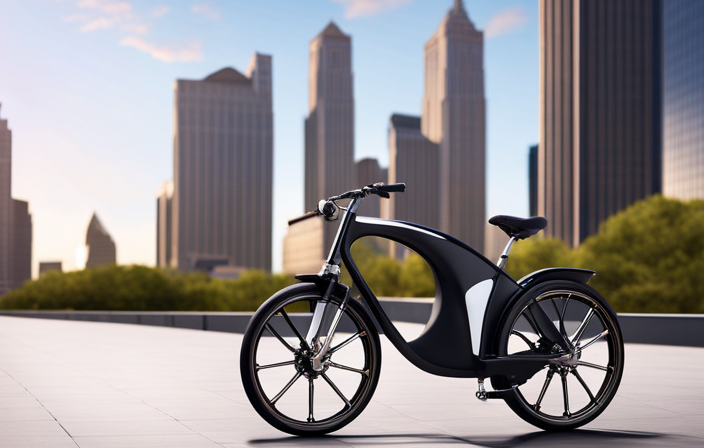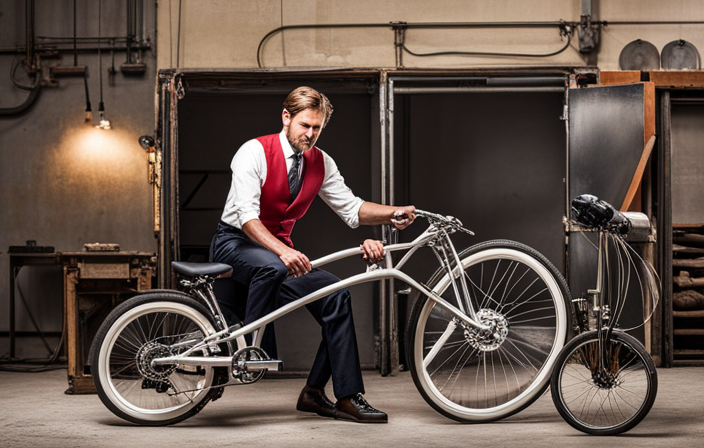As the sun sets on the horizon, the quiet hum of an electric bike echoes through the streets. But is it really just a bike? Or is it something more?
In this article, we will delve into the fascinating world of electric bikes and explore the line between two-wheeled bliss and motorcycle might. From speed limits to registration requirements, pedal-assist to throttle control, join me on this journey to unravel the mysteries of when an electric bike becomes a motorcycle.
Key Takeaways
- Different regulations exist for off-road and street use of electric bikes.
- Electric bikes are subject to weight and size restrictions for off-road use.
- Street use regulations include speed limits and safety feature requirements for electric bikes.
- The line between electric bikes and motorcycles is becoming blurred due to the increasing power of electric bikes.
Definition of an Electric Bike
When is an electric bike considered a motorcycle?
The answer to this question lies in the definition of an electric bike.
An electric bike, also known as an e-bike, is a bicycle equipped with an electric motor that assists the rider’s pedaling.
However, future innovations in e-bikes are blurring the line between bicycles and motorcycles.
Industry standards play a crucial role in determining when an electric bike crosses over into motorcycle territory.
These standards typically involve speed and power limits.
For example, if an electric bike can reach speeds exceeding 20 miles per hour or has a motor with a power output greater than 750 watts, it may be classified as a motorcycle.
As we delve into the next section about speed and power limits, we will explore this topic further.
Speed and Power Limits
Although an electric bicycle can reach high speeds, it is important to understand the speed and power limits. Here are some key points to consider:
-
Speed limits: In many countries, electric bikes are subject to speed restrictions. Typically, these limits range from 20 to 28 miles per hour (32 to 45 kilometers per hour). Exceeding these limits may require the bike to be classified as a motorcycle.
-
Power restrictions: Electric bikes are often limited in terms of motor power output. The maximum power allowed varies by jurisdiction, but it is typically around 750 watts. Going beyond this limit could also push the bike into motorcycle territory.
-
Pedal-assist vs. throttle-only: Some countries differentiate between pedal-assist electric bikes and those with throttle-only control. Pedal-assist bikes require the rider to pedal in order to activate the motor, while throttle-only bikes can be propelled solely by the motor. Different speed and power restrictions may apply to each type.
-
Compliance is crucial: It is important to adhere to speed and power limits to ensure that your electric bike remains classified as a bicycle and not a motorcycle. Violating these limits may require licensing and registration requirements.
Now, let’s delve into the licensing and registration requirements for electric bikes.
Licensing and Registration Requirements
To legally operate an electric bicycle, individuals may need to obtain appropriate licenses and register their vehicles. Licensing requirements for electric bikes vary by country and even by state or province within a country. In some places, electric bicycles are treated similarly to traditional bicycles and do not require any special licenses. However, in other areas, a specific license or permit may be necessary, especially if the electric bike has a higher power output or top speed. Registration requirements for electric bicycles also differ. Some jurisdictions require registration for all electric bikes, while others only require it for certain types or models. It is important for electric bike riders to familiarize themselves with the specific licensing and registration requirements in their area to ensure compliance with the law. With that said, let’s delve into the differences between pedal-assist and throttle-controlled electric bikes.
Pedal-Assist vs. Throttle-Controlled
If you’re considering buying an e-bike, understanding the difference between pedal-assist and throttle-controlled models is important.
Pedal-assist e-bikes are designed to provide a boost to your pedaling effort, making it easier to climb hills or ride longer distances. This feature is particularly beneficial for those who want to get some exercise while still enjoying the convenience of an electric motor.
On the other hand, throttle-controlled e-bikes allow you to use a throttle to control the speed without pedaling. While this may seem convenient, it does have its drawbacks. Throttle-controlled e-bikes tend to have a shorter battery life and can be less efficient compared to pedal-assist models. Additionally, some jurisdictions may have stricter regulations for throttle-controlled e-bikes, requiring additional licensing or registration.
Understanding these differences can help you make an informed decision when choosing the right e-bike for your needs.
Moving on to weight and size restrictions…
Weight and Size Restrictions
When considering purchasing an e-bike, it’s important to be aware of any weight and size restrictions you might encounter. Many countries and states have regulations in place that dictate the maximum weight and size an electric bike can have in order to be classified as a bicycle rather than a motorcycle.
These restrictions are in place to ensure the safety of riders and pedestrians, as well as to prevent electric bikes from being too powerful or bulky. Weight restrictions typically range from 50 to 100 pounds, depending on the jurisdiction, while size limitations often include specifications for the length, width, and height of the bike.
By understanding and adhering to these restrictions, you can ensure that your e-bike remains legally classified as a bicycle.
Moving on to safety equipment requirements, it is also important to consider the necessary gear to ride your e-bike safely.
Safety Equipment Requirements
It’s crucial to have the proper safety equipment for riding an e-bike. Just like with motorcycles, safety gear is essential to protect yourself in case of an accident.
When it comes to e-bikes, helmet requirements vary depending on local regulations. Some areas may require all riders to wear a helmet, while others may only mandate it for riders under a certain age. Regardless of the legal requirements, it is highly recommended to always wear a helmet while riding an e-bike.
Additionally, it’s a good idea to invest in other safety gear such as knee and elbow pads, reflective clothing, and gloves. These can provide extra protection and increase your visibility on the road.
Now, let’s move on to the next topic and discuss insurance and liability considerations.
Insurance and Liability Considerations
Transition: Now that we have discussed the safety equipment requirements for electric bikes, let’s turn our attention to another important aspect: insurance and liability considerations.
Current Subtopic: Insurance and Liability Considerations
When it comes to electric bikes and their classification, it is essential to consider the international standards that define what separates them from motorcycles. These standards vary across countries and can impact insurance requirements. As the popularity of electric bikes continues to rise, insurance companies are adapting their policies to accommodate this growing market. Anticipated developments in insurance coverage may include specialized plans tailored to electric bike riders, providing coverage for theft, accidents, and personal liability.
To better understand your insurance needs, it is crucial to consult with your insurance provider and inquire about their specific coverage options for electric bikes. By doing so, you can ensure that you are adequately protected in case of any unforeseen incidents.
Transition: With insurance and liability considerations addressed, let’s now delve into the topic of off-road vs. street use.
Off-Road vs. Street Use
When it comes to electric bikes, it’s important to understand the different regulations for off-road and street use.
Off-road electric bikes may have fewer restrictions, allowing for more freedom and flexibility in where they can be ridden.
However, there are certain areas or trails that may have specific restrictions on electric bike usage, so it’s crucial to be aware of these limitations before hitting the trails.
Different regulations for off-road and street use of electric bikes
The regulations for off-road and street use of electric bikes differ.
When it comes to off-road use, electric bikes are often classified based on whether they are pedal-assist or throttle-controlled. Pedal-assist electric bikes require the rider to pedal in order to activate the motor, while throttle-controlled electric bikes can be propelled solely by using the throttle. Additionally, there may be weight and size restrictions for off-road electric bikes in certain areas or trails.
On the other hand, when it comes to street use, electric bikes are subject to different regulations, such as speed limits and the requirement of certain safety features like lights and reflectors. These regulations aim to ensure the safety of riders and other road users.
Transitioning into the next section, it is important to note that there are also restrictions on electric bikes in certain areas or trails.
Restrictions on electric bikes in certain areas or trails
Be aware of specific limitations and constraints on where you can ride your e-bike in certain areas or trails. Restrictions on electric bikes vary depending on the location and the type of trail or area.
Some areas may have specific rules prohibiting the use of electric bikes altogether, while others may have restrictions on certain trails or designated areas. These restrictions are in place to ensure safety and protect the environment. Violating these restrictions can have legal implications, such as fines or even the confiscation of your e-bike.
It is important to research and familiarize yourself with the rules and regulations of the specific area or trail you plan to ride in. By doing so, you can enjoy your e-bike while also respecting the restrictions that are in place.
Now let’s explore the international classification standards for electric bikes.
International Classification Standards
When it comes to classifying electric bikes, different countries have different standards. This can create confusion and inconsistencies, especially for manufacturers and consumers operating on a global scale.
However, there have been efforts to harmonize these classification standards, aiming to create a unified system that ensures clarity and consistency across borders.
Comparison of classification standards across different countries
You should consider the comparison of classification standards across different countries when determining whether an electric bike is a motorcycle.
International classification standards for electric bikes vary greatly from country to country, making it challenging to determine their classification. Some countries use speed limits as the primary factor, considering electric bikes with a maximum speed of 20 mph as bicycles, while others use power limits, classifying electric bikes with a motor power below a certain threshold as bicycles.
Additionally, some countries have specific regulations for electric bikes with pedal-assist systems, while others do not. These variations in classification standards reflect different perspectives on safety, environmental impact, and urban mobility.
As future trends point towards the increasing popularity of electric bikes, harmonization efforts for electric bike classification are necessary to ensure consistency and facilitate international trade and travel.
Harmonization efforts for electric bike classification
To better understand the classification of electric bikes, it’s important to be aware of ongoing efforts to harmonize their classification standards internationally. International harmonization is crucial because it ensures consistency and promotes safety standards across different countries.
Here are three key points regarding the harmonization of electric bike classification:
-
The European Union (EU) has taken a significant step towards harmonization by implementing the EN 15194 standard. This standard defines the requirements for electric bikes and helps ensure the safety of riders.
-
The United States is also making efforts to harmonize electric bike classification by adopting the three-class system. This system categorizes electric bikes based on their maximum assisted speed and power output, providing clear guidelines for manufacturers and consumers.
-
The International Organization for Standardization (ISO) is working towards developing global standards for electric bikes. This would further facilitate harmonization efforts and create a unified approach to electric bike classification worldwide.
Considering the ongoing international harmonization efforts, it is evident that the classification of electric bikes is evolving and adapting to ensure safety and consistency. Looking ahead, let’s explore future trends and potential changes in classification.
Future Trends and Potential Changes in Classification
In discussing the future trends and potential changes in electric bike classification, it is important to consider the anticipated developments in electric bike regulations.
As technology continues to advance, electric bikes are becoming more powerful and capable, blurring the line between bikes and motorcycles.
Policymakers face the challenge of defining electric bike classification in a way that balances safety concerns with the continued growth and innovation in the industry.
Anticipated developments in electric bike regulations
When it comes to anticipated developments in electric bike regulations, it’s important to consider how these changes will impact the classification of electric bikes as motorcycles.
The international standards for electric bike classification are expected to become more refined and comprehensive. This will provide clearer guidelines for determining when an electric bike should be classified as a motorcycle.
Additionally, there may be an increased focus on performance-based criteria such as speed and power output. This could help address the current challenges in classification, where some electric bikes blur the line between bicycles and motorcycles.
Furthermore, there may be efforts to establish a harmonized classification system across different countries to facilitate global trade and ensure consistency.
These anticipated developments in electric bike regulations will contribute to a more standardized approach to classifying electric bikes and ensure that the regulations keep pace with the evolving technology. This will be crucial for policymakers as they navigate the challenges and considerations in defining electric bike classification.
Challenges and considerations for policymakers in defining electric bike classification
One challenge I face as a policymaker is determining the appropriate classification for electric bikes. With the increasing popularity of electric bikes, it is crucial to establish clear guidelines to ensure safety and regulate their use on the roads.
One consideration is the need for international collaboration in defining electric bike classification. Since electric bikes are used globally, it is essential to have consistent regulations to avoid confusion and facilitate trade.
Additionally, policymakers must consider the environmental impact of electric bikes. While they offer a greener alternative to traditional motorcycles, there may be concerns regarding the disposal of batteries and their overall carbon footprint.
Striking a balance between promoting sustainable transportation and addressing potential environmental issues is a key challenge that policymakers must address in classifying electric bikes.
Frequently Asked Questions
Can an electric bike be classified as a motorcycle if it exceeds the speed limit for electric bikes?
If an electric bike exceeds the speed limit for electric bikes, it can be classified as a motorcycle. This has legal implications, as the regulations for motorcycles differ from those for electric bikes.
Are there any specific requirements for insurance or liability coverage for electric bikes that are considered motorcycles?
To ensure compliance with insurance requirements and liability coverage, electric bikes that are classified as motorcycles may need to meet specific criteria. This can vary depending on local regulations and may include factors such as speed capabilities and licensing requirements.
Can an electric bike be used off-road if it meets the requirements to be classified as a motorcycle?
Yes, an electric bike can be used off-road if it meets the legal requirements to be classified as a motorcycle. It must have the necessary off-road capabilities and adhere to all applicable regulations.
Are there any weight or size restrictions for electric bikes to be categorized as motorcycles?
Weight and size restrictions for electric bikes to be categorized as motorcycles vary by jurisdiction. These restrictions ensure that the vehicle meets certain safety standards and can be operated safely on public roads.
How do international classification standards differ for electric bikes that are considered motorcycles?
International classification standards for electric bikes vary in their speed limit requirements. Some countries classify electric bikes as motorcycles if they exceed a certain speed limit, while others have different criteria such as power output or weight.
Conclusion
In conclusion, understanding the classification of electric bikes is crucial for riders to navigate the legal requirements and restrictions that apply to their use.
As the popularity of electric bikes continues to rise, it is important to stay informed about the evolving regulations and future trends in this industry.
Remember, ‘knowledge is power,’ and by staying informed, riders can make responsible choices and enjoy the benefits of electric bikes while staying within the guidelines set by authorities.
So, keep riding, keep learning, and stay safe on the roads!









